Merle (dog coat)
Merle is a genetic pattern that can be in a dog's coat. Merle comes in different colors and patterns and can affect all coat colors. The merle gene creates mottled patches of color in a solid or piebald coat, blue or odd-colored eyes, and can affect skin pigment as well. There are two general types of colored patches that will appear in a merle coat: liver (red merle) and black (blue merle). Some breeds that can be affected by this genetic trait are Australian Shepherds and Catahoula Leopard Dogs. This genetic trait should be taken seriously when breeding merles. Health issues are more typical and more severe when two merles are bred together, so it is recommended that a merle be bred with a non-merle dog of any other color.
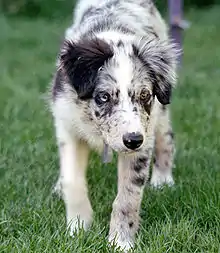
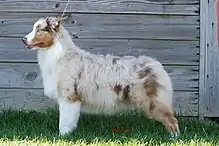
Description
Merle can affect all coat colors. The merle forms of brown and black are usually called "red" (though this is not correct; red and brown are genetically different) and "blue" as patches of blue are formed throughout the coat. Dogs who are recessive red can still be affected by merle, but the patches are either hardly seen or, if the dog is a clear recessive red, are not visible at all.[1][2] Combinations such as brindle and sable merle exist, but are not typically accepted in breed standards.[2]
In addition to altering base coat color, merle also modifies eye color and coloring on the nose and paw pads. The merle gene modifies the dark pigment in the eyes, occasionally changing dark eyes to blue, or part of the eye to be colored blue. Since merle causes random modifications, however, both dark-eyed, blue-eyed, and odd-colored eyes are possible.[3] Pigmentation on paw pads and nose may be mottled by pink.[4]
Breeds
Merle is a distinguishing marking of several breeds, particularly the Australian Shepherd and Catahoula Leopard Dog, and appears in others, including the Koolie, German Coolies in Australia, the Shetland Sheepdog, various collies, the Welsh Corgi (Cardigan), the Pyrenean Shepherd and the Bergamasco Sheepdog.[5] In dachshunds the merle marking is known as "dapple".[6] The merle gene also plays a part in producing harlequin Great Danes. Harlequin Beaucerons are genetically merle.
Depending on the breed, registry, or country, the pattern may be register-able with a registry but not allowed in conformation, and the pattern may not be recognized by the breed standard, disqualifying it from showing.[7][8] There may also be additional requirements for the pattern such as the dog being allowed to have the pattern but must have completely dark eyes with no blue in them.[9]
Merle is sometimes introduced to other purebred dog breeds through crossbreeding, but these dogs are not purebred and cannot be registered with any reputable kennel club. [10] Just recently the UK Kennel Club (the oldest in the World) has banned the registration of merle Poodles as they are not and never have been a colour recognised in pure Poodles. [11]
Genetic basis
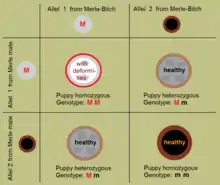
Merle is actually a heterozygote of an incompletely dominant gene.[13] If two such dogs are mated, on the average one quarter of the puppies will be "double merles", which is the common term for dogs homozygous for merle,[14] and a high percentage of these double merle puppies could have eye defects and/or be deaf. Knowledgeable and responsible breeders who want to produce merle puppies mate a merle with a non-merle dog; roughly half the puppies will be merles, and none will have the vision or hearing defects associated with double merle dogs.[15]
In January 2006 scientists at Texas A&M University announced the discovery of a mobile genetic unit called a retrotransposon, responsible for the merle mutation in dogs.[16] Merle can be tested for and identified through DNA.[17]
A phantom merle or cryptic merle is one with such small patches of merle—or none at all—that it appears to be a non-merle.[18] This is commonly seen in dogs who are recessive red, clear recessive reds in particular, though patches can still be seen in certain red dogs.[19] In America, a dog with the phantom merle coloring is described as being "cryptic for merle." A cryptic merle bred to a merle may produce merles, cryptic merles, or homozygous merles.[20] Another mutation for cryptic merle has been identified by Dr. Helena Synková, and has been given the working name of "atypical merle". It is recommended that if a breeder is unsure if their dog is merle or not, that they be tested for the merle gene.[8]
Merle modifiers
Certain "modifying genes" work in tandem (co-dominate expressive) with the merle gene to create a completely different look to the pattern.
Often mistaken for a "double merle", a harlequin merle (or just harlequin), is a dog that carries both the merle pattern gene and the co-dominate modifying gene (carried on a different locus) for harlequin. This causes most or all of the "blue" to be replaced with white, leaving a dog that is mostly white with black patches. All dogs exhibiting the harlequin pattern are also carriers of the merle gene. Common in Great Danes, (and registered as Harlequin) it is less commonly seen in other breeds such as the Catahoula Leopard Dog, Shetland Sheepdog and Collie, where the dogs are registered simply as merle.[10]
In 2018, a published paper identified multiple different types of merle that affect coat color differently.[21]
Health issues
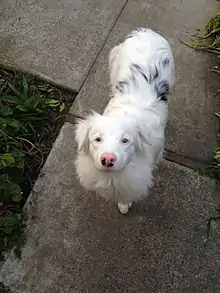
Dogs with two copies of the merle gene (homozygous merle or "double merle") have an even higher chance of being deaf and with vision impairments.[22] The UK Kennel Club has acknowledged the health risk associated with homozygous merle and stopped registering puppies produced from merle to merle matings in 2013. Merle to merle mating is currently only forbidden in three breeds.[23] Recent research indicates that the majority of health issues occur in dogs carrying both piebald and merle genes.
The suppression of pigment cells (melanocytes) in the iris and in the stria vascularis of the cochlea (inner ear) leads to blue eyes and deafness. An auditory-pigmentation disorder in humans, Waardenberg syndrome, reflects some of the problems associated with heterozygous and homozygous merle dogs and genetic research in dogs has been undertaken with the goal of better understanding the genetic basis of this human condition.[16]
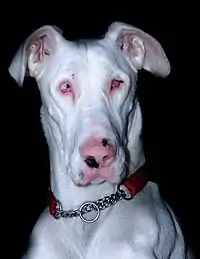

Ocular defects
Dogs who are homozygous for the merle pattern gene often have visual and auditory deficits.[18] These dogs are sometimes referred to as 'double merle' and sometimes incorrectly referred to as 'lethal white'. Ocular defects include microphthalmia, conditions causing increased ocular pressure, and colobomas, among others.[24] Double merle dogs may be deaf or blind or both, and can carry ocular defects in blue or colored eyes.[25] Currently no studies have been done to prove whether or not the merle gene affects the eyes, causing blindness.
Auditory defects
In one study of 38 dachshunds by a German researcher, partial hearing loss was found in 54.6% of double merles and 36.8% of single merles. 1 out of the 11 (9.1%) double merles was fully deaf while none of the single merles were.[26] Another study done by Texas A&M University found that of 22 double merles, 8 were completely deaf and two were deaf in one ear. Of 48 single merles, only one was deaf in one ear, and none were completely deaf.[26] In another study of 70 dogs, 15 of them Catahoula Curs, 4 of the Catahoulas were deaf, while 86% of the double merles of other breeds were deaf.[26]
Deaf, blind, and deaf and blind dogs can have good lives when properly cared for. There are a variety of internet groups dedicated to supporting carers of such dogs. Deaf dogs can compete successfully in agility[27] and there are many anecdotal reports of deaf/blind dogs earning their Canine Good Citizen certification, working as therapy dogs, and competing in dog sports like tracking or Nosework.
Gallery
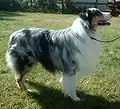 Blue merle Australian Shepherd
Blue merle Australian Shepherd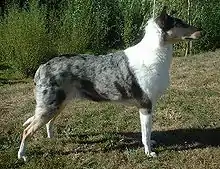 Blue merle Smooth Collie
Blue merle Smooth Collie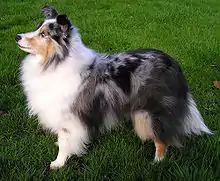 Blue merle Shetland Sheepdog
Blue merle Shetland Sheepdog Blue merle Catahoula Leopard Dog
Blue merle Catahoula Leopard Dog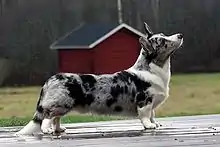 Blue merle Cardigan Welsh Corgi
Blue merle Cardigan Welsh Corgi Blue merle Mudi
Blue merle Mudi Blue merle (silver dapple) Miniature Dachshund
Blue merle (silver dapple) Miniature Dachshund Blue merle Pomeranian
Blue merle Pomeranian Blue merle Chihuahua
Blue merle Chihuahua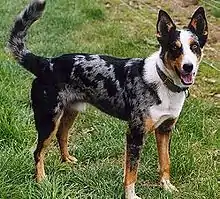 Blue merle Koolie.
Blue merle Koolie.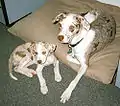 Liver merle Catahoula Leopard Dogs
Liver merle Catahoula Leopard Dogs Liver merle (chocolate dapple) Dachshund
Liver merle (chocolate dapple) Dachshund
 Black merle Bergamasco Shepherd
Black merle Bergamasco Shepherd Red merle American Cocker Spaniel.
Red merle American Cocker Spaniel. From left to right, black,sable and white, sable Merle mixed breed puppies.
From left to right, black,sable and white, sable Merle mixed breed puppies. Blue merle Cockapoo
Blue merle Cockapoo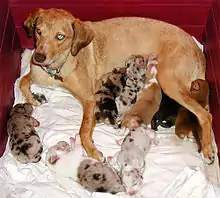 Louisiana Catahoula Leopard Dog bitch with Merle and coat-colour genotype "ee" (recessive red) has puppies from a Merle male. About 25% of them will suffer from severe deformities.
Louisiana Catahoula Leopard Dog bitch with Merle and coat-colour genotype "ee" (recessive red) has puppies from a Merle male. About 25% of them will suffer from severe deformities.
See also
References
- Schmutz, Sheila. "Schmutz - Merle coat color genetics". Sheila Schmutz. Retrieved 28 October 2011.
- Presberg, Carole. "Recessive Red Merle Border Collie". Carole Presberg. Archived from the original on 21 November 2011. Retrieved 28 October 2011.
- McDonald, Lisa. "Aussie Eye Color". Lisa McDonald. Archived from the original on 7 October 2011. Retrieved 28 October 2011.
- "Merle Coat, mottled paw pads". Perfect Peks Kennel. Archived from the original on 3 March 2011. Retrieved 28 October 2011.
- Born, Charles. "Merle Color in Cocker Spaniels". American Spaniel Club. Retrieved 20 April 2018.
- "The Double Dapple". The Dachshund Magazine Online. Retrieved June 25, 2007.
- "Chihuahua Club of Canada - Merle Breeding Ban". Chihuahua Club of Canada. Retrieved 20 April 2018.
- Born, Charles. "Merle Color in Cocker Spaniels". American Spaniel Club. Retrieved 20 April 2018.
- Born, Charles. "Pomeranian Colors - Any other allowable color". American Pomeranian Club. Retrieved 20 April 2018.
- "Dog Coat Colour Genetics". doggenetics.co.uk.
- https://www.thekennelclub.org.uk/press-releases/2020/january/registration-of-dogs-of-merle-colouring/
- Jess Chappell: Dog Coat Colour Genetics: Doppel-Merle http://www.doggenetics.co.uk/merle.html#double
- Sheila, Schmutz. "Schmutz - Merle". Sheila Schmutz. Retrieved 27 October 2011.
- "White Aussies Brochure" (PDF). White Aussies Project. Retrieved 27 October 2011.
- "Double Merle". White Aussies Project. Retrieved 27 October 2011.
- Clark, LA; Wahl JM; Rees CA; Murphy KE (31 Jan 2006). "Retrotransposon insertion in SILV is responsible for merle patterning of the domestic dog". Proc. Natl. Acad. Sci. U.S.A. 103 (5): 1376–81. doi:10.1073/pnas.0506940103. PMC 1360527. PMID 16407134.
- "UC Davis - Merle genetic testing". UC Davis. Retrieved 20 April 2018.
- Coile, D. Caroline (1999). "Obtaining an Australian Shepherd". Australian Shepherds. Barron's. pp. 20–21. ISBN 978-0-7641-0558-6.
- Schmutz, Sheila. "Schmutz - Merle". Sheila Schmutz. Retrieved 27 October 2011.
- "Cryptic Merles". ASHGI. Retrieved 20 April 2018.
- Langevin, Mary; Synkova, Helena; Jancuskova, Tereza; Pekova, Sona (20 September 2018). "Merle phenotypes in dogs – SILV SINE insertions from Mc to Mh". PLOS ONE. 13 (9): e0198536. doi:10.1371/journal.pone.0198536. ISSN 1932-6203.
- Strain, GM; Clark LA; Wahl JM; Turner AE; Murphy KE. (3 March 2009). "Prevalence of deafness in dogs heterozygous or homozygous for the merle allele". Journal of Veterinary Internal Medicine. 23 (2): 282–6. CiteSeerX 10.1.1.693.7956. doi:10.1111/j.1939-1676.2008.0257.x. PMID 19192156.
- "Merle to merle mating in dogs". The Kennel Club. 18 May 2012. Archived from the original on 1 July 2012. Retrieved 7 September 2012.
- Gustafson, JP; et al., eds. (2008). Genomics of Disease. p. 81. ISBN 978-0-387-76722-2.
- "Eye defects in Australian Shepherds". Retrieved 16 April 2011.
- "George Strain on Merle" (PDF). Merle Poms. Retrieved 27 October 2011.
- "Deaf Dogs Roundtable". Retrieved 16 April 2011.
External links
| Wikimedia Commons has media related to Merle (coat colour in dogs). |
- Merle dog coat color genetics
- Deafness in Dogs and Cats
- White Aussies Project
- Genetics of merle dogs
- ASCA. "Basic Body Colors of the Australian Shepherd". Archived from the original on 2007-04-08. Retrieved 2007-05-15.: Basic, simple-language explanation of Australian Shepherd merle colorings
- Homozygous "Lethal White" Merles
- Border Wars - Double Merle Articles
- Banning of Merle 'pattern' Chihuahua in Canada
- Catahoula Coat Color Genetics - Introduction and History of Merle
https://www.americanspanielclub.org/about-the-breed/merle-color-in-cocker-spaniels/
